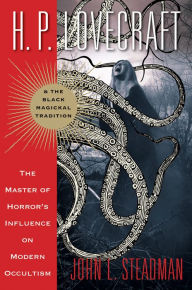It’s undeniable that the occult influenced Lovecraft’s work. The spooky, mysterious rituals appeared so often in his short stories that ardent fans could spot the hooded figure and know the number of pages coming before the denoument. What’s more of a question – given that Lovecraft was a neighbor to the occult like a vanilla person can sometimes have kinky friends and thus pick up the lingo – was how much he influenced the occult movements of his own time and beyond. John Steadman digs into the journals and letters of Lovecraft and into magical traditions ranging from Wicca to Chaos magic to identify how far those influences went.
His arguments, mostly about Lovecraft’s influence on magic are compelling in many areas, especially when it comes to Chaos magick and LaVeyan Satanism. There are two groups he delves into, however, where this argument is much more difficult to accept. In the concluding chapter, hestates, “I have shown that Lovecraft has had an indirect, though clearly definable, influence on current Vodou and Wiccan practices.” It is one of those statements that prompts any reader that practices either of these traditions to stop and say, “Woah, back up there, buddy.”
Steadman certainly posits – with excessive explanation that often fails to link it to the core thesis of his book – that Lovecraft shaped certain aesthetics that permeated all of occultism. However, his definition of black magic once outside of non-theistic practices breaks down. If anything, black magic in its most adopted concept is simply code for “non-theistic,” and that makes it compatible with the ideas of chaos and some branches of ceremonial magic.
But to insist on a connection with these two religions is to be dismissive of the modern realities of both, particularly as Steadman classes any religion with a “Dionysian” (read: ecstatic) element as black magick. Certainly Lovecraft may have perceived any and all magickal practices as black magick – but the theistic roots of Voudon and Wicca are completely outside the aesthetics and intents of a Lovecraftian world for the simple reason that both traditions believe that their gods, saints, and ancestors are awake, involved, and concerned.
This is one of those books that’s frustrating because there is so much truly great material in it, eclipsed by the author’s either biased or underinformed data about specific areas of practice. Yes, the most famous Necronomicon explicitly mentions Wicca and somehow links it to Tiamat – but few longstanding Wiccan traditions gravitate towards Sumer, and most have interest in gods already awake, alert, and open to direct conversation.
Setting aside the frustration of immanence versus Lovecraftian interpretation, the passages about various Necronomicons that have surfaced over the past two centuries is fascinating.
The various -and usually fraudulent – versions of the Necronomicon each have their own stories, and Steadman sets forth a compelling argument for the “truth” (a still very odd one) of the best known Necronomicon. The author is also consistent – and persistent – in his assertion, well backed up with statements made by the author of whom he writes – that Lovecraft was only as mystical as the science of his time allowed. The often eerie rites mentioned in his book often gave the peripheral descriptions the friendly neighborhood UCC member might have if she discovered her neighbors performing modern Druidic rites in their backyard.
Alas, the thoroughness of the research of the book was also its downfall in two ways. First, when it came to topics such as Wicca, Druidry, and Voudon, the author went with inaccurate and often outdated information. The links to Lovecraftian influence were so weak as to be mere coincidence. Second, there were many, many passages of the book that explained different traditions so far beyond what was necessary that the connections to Lovecraft’s work – whether an influence on or influenced by – was lost in the natter of excess data. A good read that does give some solid and possibly final answers on the Necronomicon, but problematic in the way Steadman classifies and links traditions to Lovecraft.
~ review by Diana Rajchel
Author: John L. Steadman
Weiser Books, 2015
pp. 285; $22.95
H.P. Lovecraft & the Black Magickal Tradition: the Master of Horror’s Influence on Modern Occultism

©
2010 - 2025
Facing North
